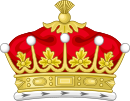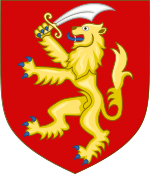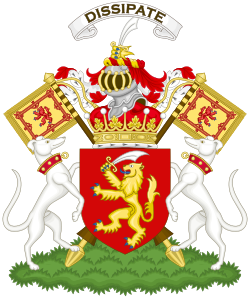Earl of Dundee facts for kids
Quick facts for kids Earldom of Dundee |
|
|---|---|
| Creation date | 1660 |
| Monarch | Charles II |
| Peerage | Peerage of Scotland |
| First holder | John Scrymgeour, 3rd Viscount Dudhope |
| Present holder | Alexander Scrymgeour, 12th Earl of Dundee |
| Heir apparent | Henry David Scrymgeour-Wedderburn of that Ilk, Lord Scrymgeour |
| Subsidiary titles | Viscount of Dudhope Baron Glassary of Glassary, Argyll Lord Scrymgeour Lord Innerkeithing |
| Status | extant |
| Seat(s) | Birkhill |
The Earl of Dundee is a special noble title in Scotland. It was first created in 1660 for a man named John Scrymgeour. A "peerage" is a system of noble titles, like Duke, Marquis, Earl, Viscount, and Baron.
When the first Earl John Scrymgeour died in 1668, the King's officials thought he had no male heirs. So, the title became "dormant," meaning it was put on hold. The lands and duties that came with the title were given to someone else.
However, in 1953, it was discovered that the first Earl did have male heirs! So, the title was brought back, or "revived." It was given to Henry James Scrymgeour-Wedderburn. He had worked in the British government before, in the House of Commons and the Cabinet.
The Earl of Dundee also holds other, smaller titles. These are called "subsidiary titles." They include Viscount of Dudhope and Lord Scrymgeour. These were created in 1641 during a time of conflict called the Bishops' Wars. Later, in 1660, the Earl received another title: Lord Innerkeithing. In 1954, the 11th Earl was also made Baron Glassary of Glassary, Argyll. Most of these titles are part of the Scottish peerage, but the Barony of Glassary is part of the United Kingdom peerage.
The oldest son and future heir of the Earl is known by the courtesy title of Lord Scrymgeour.
The family's main home is called Birkhill. It is located near Cupar in Fife, Scotland.
Contents
History of the Dundee Earldom
The story of the Earls of Dundee goes back a very long time. In 1107, a brave knight named Sir Alexander Carron was given the nickname Schyrmeschur. This means "The Swordsman." He earned it for his heroic actions in battle.
King Alexander I gave him the right to use the name Schyrmeschur and special symbols for his family. He also gave him the important job of Hereditary Royal Standard-Bearer of Scotland. This meant his family would always have the honor of carrying the Royal Banner (a special flag) in front of the King or Queen. They would also carry it before the Scottish Army during wartime.
In 1298, another Sir Alexander Schyrmeschur was given the job of Constable of Dundee. This was an important role in the town.
Royal Standard Bearer of Scotland
The role of carrying the Royal Standard is a very old and important one. Sir Alexander Schyrmeschur received this honor in 1107. It was meant to be passed down through his family.
Over the centuries, there were some disagreements about who had the right to carry the standard. In 1676, King Charles II tried to give this job to someone else. However, the Scrymgeour family continued to claim their right.
In 1820, Henry Scrymgeour-Wedderburn confirmed his family's right to this office. He even carried the standard at a special event in 1822. This right was confirmed again in 1902 and 1952. Today, the Earl of Dundee still carries the lion rampant flag, which is the Royal Banner, at important royal events.
Constable of Dundee
In 1298, Sir Alexander Schyrmeschur, who was the Hereditary Royal Standard Bearer, fought bravely for Sir William Wallace. Wallace was a famous Scottish hero. As a reward for his courage, Sir Alexander was given the title of Constable of Dundee Castle. He also received land nearby.
At first, this title was for his lifetime. But in 1324, King Robert I made it a hereditary title. This meant it would pass down to his son Nicolas and future generations. The title became dormant, or inactive, when John Scrymgeour, the 1st Earl of Dundee, died in 1668. He was the 13th Constable of Dundee.
Here are some of the people who held the title of Constable of Dundee:
- Sir Alexander Schyrmeschur (died 1306)
- Sir Nicolas Scrymseor (died 1324)
- Sir John Scrymseor (died 1332)
- Sir Alexander Scrymseor (died 1383)
- Sir James Scrymseor (died 1411)
- Sir John Scrymseor (died 1465)
- Sir James Scrymseour (died 1478)
- Sir James Scrimgeour of Dudhope (died 1504)
- Sir James Scrymseor (died 1546)
- Sir James Scrimgeour, 10th Constable of Dundee (died 1612)
- Sir John Scrymgeour, 11th Constable (died 1643) (He was also made Viscount of Dudhope in 1641.)
Viscounts of Dudhope (1641)
This is a list of the Viscounts of Dudhope:
- John Scrymgeour, 1st Viscount of Dudhope (died 1643)
- James Scrymgeour, 2nd Viscount of Dudhope (died 1644)
- John Scrymgeour, 3rd Viscount of Dudhope (died 1668) (He was later created Earl of Dundee in 1660. The title became dormant in 1668.)
Earls of Dundee (1660)
In this list, some Earls are called "de jure." This means they had the legal right to the title, but they didn't actually hold it at the time. Others held the title "de facto," meaning they actually had it.
- John Scrymgeour, 1st Earl of Dundee (died 1668) (title became dormant in 1668)
- John Scrymgeour of Kirkton, de jure 2nd Earl of Dundee (1628–1698)
- James Scrymgeour, de jure 3rd Earl of Dundee (1664–1699)
- Dr. Alexander Scrymgeour, de jure 4th Earl of Dundee (1669–1739)
- David Scrymgeour of Birkhill, de jure 5th Earl of Dundee (1702–1772)
- Alexander Scrymgeour-Wedderburn, de jure 6th Earl of Dundee (1742–1811)
- Henry Scrymgeour-Wedderburn, de jure 7th Earl of Dundee (1755–1841)
- Frederick Lewis Scrymgeour-Wedderburn, de jure 8th Earl of Dundee (1808–1874)
- Henry Scrymgeour-Wedderburn, de jure 9th Earl of Dundee (1840–1914)
- Henry Scrymgeour-Wedderburn, de jure 10th Earl of Dundee (1872–1924)
- Henry James Scrymgeour-Wedderburn, 11th Earl of Dundee (1902–1983) (title revived in 1953)
- Alexander Henry Scrymgeour, 12th Earl of Dundee (born 1949)
The person who will inherit the title next is the current Earl's son. His name is Henry David Scrymgeour-Wedderburn of that Ilk, Lord Scrymgeour (born 1982). His son, Hon. Tassilo Alexander Robert Scrymgeour-Wedderburn, Master of Scrymgeour (born 2005), is next in line after him.
Coat of Arms
|
The Coat of Arms for the Earl of Dundee is very special. It shows a red shield with a golden lion standing on its hind legs. The lion holds a curved sword. Behind the shield, you can see two images of the Royal Banner of Scotland. This is because the Earls of Dundee have the special job of being the Hereditary Royal Standard Bearers for Scotland. This means they are allowed to show the Royal Banner in their family's coat of arms.




